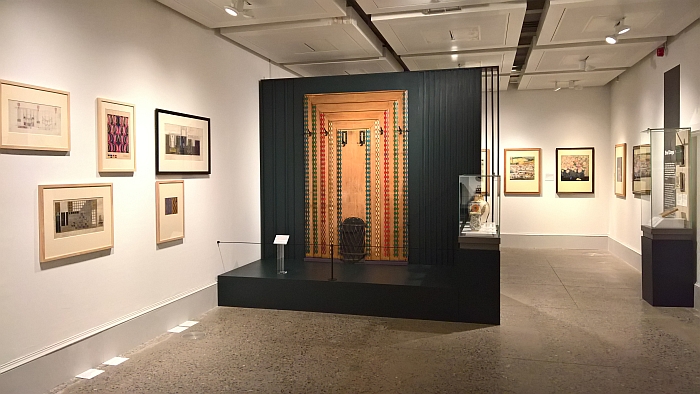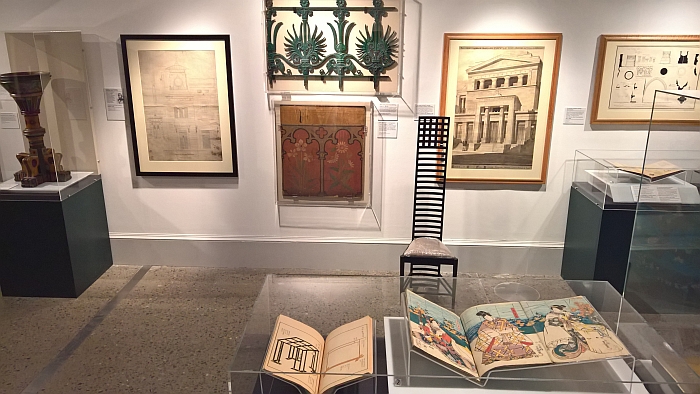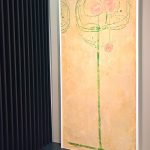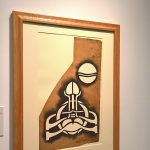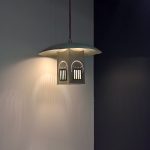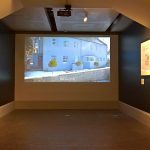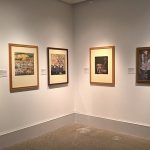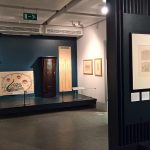Charles Rennie Mackintosh. Making the Glasgow Style @ Kelvingrove Art Gallery and Museum, Glasgow
“Shake of all the props – the props tradition and authority offer you – and go alone – crawl – stumble – stagger – but go alone”, encouraged the Scottish architect, designer and artist Charles Rennie Mackintosh his audience during his 1902 lecture Seemliness.1
How Charles Rennie Mackintosh himself attempted to do just that can be explored in the exhibition Charles Rennie Mackintosh. Making the Glasgow Style.
Born in Glasgow on June 7th 1868 as one of eleven children to William McIntosh and his wife Margaret Rennie, Charles Rennie McIntosh enrolled in evening classes at Glasgow School of Art in 1883 aged 15, and a year later began a five year apprenticeship with Glasgow architect John Hutchison. Following completion of his apprenticeship in 1889 McIntosh joined the larger Honeymann & Keppie architects as a draughtsman, and with whom he was to remain for the next 24 years, becoming a partner in 1904 and a period which saw him create some of his most important works including, and amongst many others, the new building for Glasgow School of Art (1897-1899 & 1907-1909), offices for the Glasgow Herald (1894) or Hill House Helensburgh (1904)
In addition to his architecture Charles Rennie McIntosh was active as an interior designer, most famous perhaps being his numerous tearoom designs for Miss Cranston; and combined interior and exterior work as a proponent of the Gesamtkunstwerk thinking of the period, that prevailing philosophy that the architect was logically responsible for all interior and exterior design.
The name change from McIntosh to Mackintosh came in 1893, the reason is lost in the mists of time; however, we’d argue that “Mac” can be considered more “Scottish” than the “Mc” one finds more commonly in Ireland. We could be wrong. We often are.
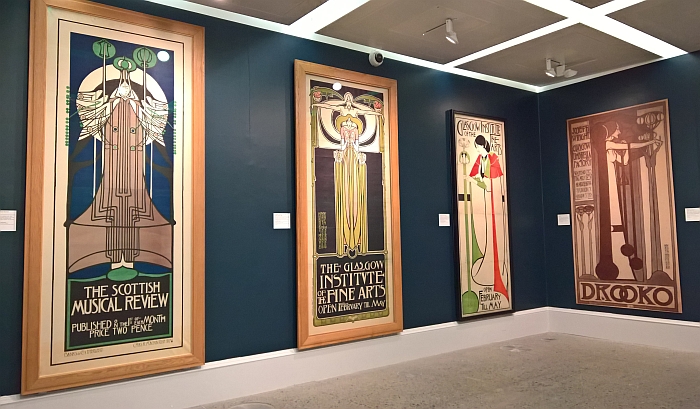
Late 19th century posters by Charles Rennie Mackintosh & Margaret Macdonald, as seen at Charles Rennie Mackintosh. Making the Glasgow Style, Kelvingrove Art Gallery and Museum, Glasgow
Presenting a chronological journey through Charles Rennie Mackintosh’s life and career, Making the Glasgow Style opens, logically and pleasingly, pre-Mackintosh with those artistic, architectural, craft and design influences which were to work on the young Charles, and for all that staple of any respectable Art Nouveau education: Japan
As previously noted in these pages, the ending of Sakoku, Japan’s 150 years of self-exposed isolation, allowed from the 1850s onwards for increasing exposure in Europe to Japanese culture, including alternative aesthetic understandings, novel construction systems and new materials which provided an impetus for those creatives looking for answers to the scientific, technical, economic and spiritual developments of the period: impetuses to which Glasgow creatives were uniquely exposed.
In 1872 Kelvingrove House was established as the city’s industrial museum, an institution which, and much as with the Applied Arts Museum’s opening around Europe at that period, enabled access to objects and materials of an unfamiliar and exotic nature, while in the same year the Iwakura Mission – a diplomatic/economic/scientific tour undertaken by Japan as a way of reintegrating itself to global politics and commerce – visited Glasgow, before in 1878 the city was presented with the so-called Japanese Gift: 31 wooden crates containing 1,150 examples of Japanese applied arts, crafts and art.
In addition, in 1881 the so-called Oriental Art Loan Exhibition opened at the city’s Corporation Galleries presenting works from across Persia and Orient, the first public exhibition of its kind in the city.
Creative relations between Japan and Glasgow where further strengthened through individuals such as the Glaswegian engineer Henry Dyer who served throughout the 1870s as Principle of the Imperial College of Engineering in Tokyo, enlisting during his tenure further Glaswegians such as the doctor William Ayrton or engineer John Perry to join him, thereby establishing an academic transfer between the two nations2. Just as importantly, when Dyer returned to Glasgow in 1882 he brought with him a unique collection of objects assembled with the contemporary engineer’s eye.
Making the Glasgow Style doesn’t explicitly link Charles Rennie Mackintosh with the above, doesn’t, for example, explicitly confirm that he visited the Oriental Art Loan Exhibition or was otherwise inspired by contemporary events, but then again he was, for example, only 10 when the Japanese Gift arrived in the city; however, Making the Glasgow Style does make clear the environment in which the young Charles Rennie Mackintosh began his career, and it is hard to imagine him not being aware of the new influences and spirit, while the links between the Japanese constructions presented in the Tankaku Zufu illustrated compendium from the Dyer Collection and Charles Rennie Mackintosh’s more quadratic furniture designs are too close to be chance alone.
A much more local influence on the development of the young Charles Rennie Mackintosh was provided, when also largely indirectly, by those Glaswegian architects a generation or so older than himself, such as John Burnet, William Leiper or Alexander “Greek” Thomson, all architects who employed various interpretations of the Gothic, Neoclassic and Scottish Baronial architecture that was popular in Victorian Glasgow and which Charles Rennie Mackintosh references in much of his own work. Greek Thomson was also posthumously important for Mackintosh who was the recipient of the 1890 Alexander Thomson Travelling Studentship which enabled him to spend a year in Italy studying the art and architecture, contemporary and classic. An electronic sketchbook from his 1891 Grand Tour being complimented in the exhibition by sketch books completed in Glasgow which help explain how Charles Rennie Mackintosh learned and the types of architecture, both medieval and more contemporary, he was exposed to during his professional education.
Having set-up Charles Rennie Mackintosh’s formative years, explaining not only his development but the context in which that occurred, the exhibition then moves onto how he translated such into his own work, and subsequently evolved as an artist.
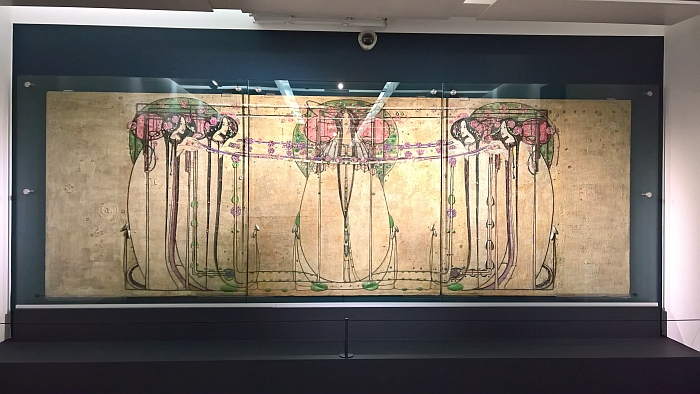
The May Queen by Margaret Macdonald, as seen at Charles Rennie Mackintosh. Making the Glasgow Style, Kelvingrove Art Gallery and Museum, Glasgow
The first works presented are early posters and paintings, works which exhibit that ornately reduced floral clarity that gives Art Nouveau its unmistakable esoteric, proto-hippy, character, before moving sprightly on to Charles Rennie Mackintosh’s architectural and interior design projects; projects which neatly underscore not only how Mackintosh understood his role in context of the Gesamtkunstwerk, but also how in the course of a decade and bit he, and much like we noted in context of Josef Hoffmann in context of the exhibition Wagner, Hoffmann, Loos at the Hofmobiliendepot Vienna, “develops from the floral geometry of Jugendstil towards a more functional and rational position”.
A development perhaps most elegantly and accessibly explained by the furniture objects presented.
Among many highlights a particular delight for us is/was a chair created for the drawing and music rooms in his 1904 interior design of Hous’hill in Glasgow’s Nitshill district: quite aside from its well-considered lines and proportions, and without even discussing the glorious way the classic stretcher has been replaced by four thinner supports to allow for a much more open, communicative work, and a work much more rational and quadratic than his earlier more organic floric forms, there is a photo of them in situ: the room divider between the drawing and music rooms being one of the type that implies separation without demanding it, while its constructive and formal elements are carried over to the chair.
Or perhaps vice versa.
Regardless, the result would appear to be a most pleasing harmony, and of the type which demonstrates that a chair can be more than simply a seating object.
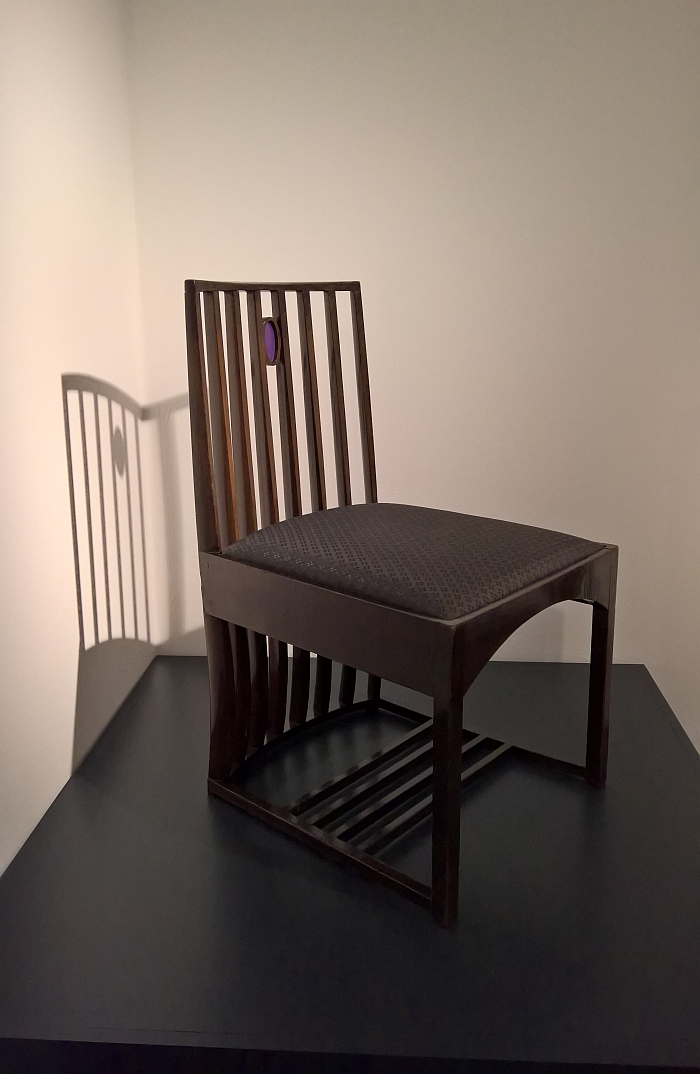
Hous’hill Chair by Charles Rennie Mackintosh, as seen at Charles Rennie Mackintosh. Making the Glasgow Style, Kelvingrove Art Gallery and Museum, Glasgow
In addition to making very clear that Charles Rennie Mackintosh was a child of his times, Making the Glasgow Style also, and in a slight contradiction to the quote with which we so confidently opened these musings, makes very clear that he was not alone in his pursuits, or perhaps better put, while he may have been crawling, stumbling, and staggering in his own manner, he was never completely by himself.
Charles Rennie Mackintosh’s most important companions were famously the other three quarters of “The Four”, a creative quadrumvirate formed at Glasgow School of Art and featuring in addition to Mackintosh, his wife Margaret Macdonald, her sister Frances Macdonald and Frances’s husband James Herbert MacNair; and a foursome who regularly cooperated on and contributed to each other’s projects. With all the inevitable cross pollination and subconscious appropriation that arises. Processes neatly illustrated and explained in the course of the exhibition
A particularly pleasing aspect of Making the Glasgow Style is that is goes beyond The Four to discuss The Five/Six/Seven/We didn’t count but certainly many more, less popularly recognised, contemporaries; contemporaries who also contributed to the cross pollination and appropriation and who therefore were also intimately involved in the development of architecture and design in Glasgow in the early 20th century.
Presenting works by the likes of, and amongst many others, Peter Wylie Davidson, Henry Taylor Wyse, George Logan, Ann Macbeth or Jessie Newbery, Making the Glasgow Style not only helps explain the wider context of Glasgow creativity at the turn of the 19th/20th centuries, nor only the importance of the Glasgow School of Art, but also allows for the comparison of Charles Rennie Mackintosh’s works with those of his contemporaries and thus allows for new perspectives, if not automatically new insights and understandings. For those you must do the homework yourselves, delve deeper, crawl, stumble and stagger a little on your own.
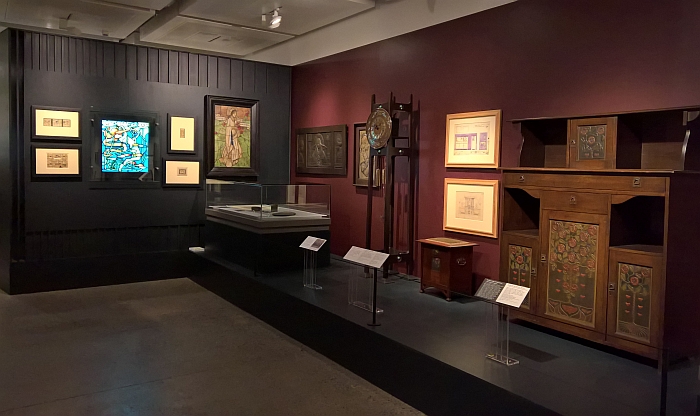
Works by Charles Rennie Mackintosh’s contemporaries, as seen at Charles Rennie Mackintosh. Making the Glasgow Style, Kelvingrove Art Gallery and Museum, Glasgow
Despite the inextricability implied in the exhibition title, Making the Glasgow Style helps makes clear the complex nature of Charles Rennie Mackintosh’s relationship with Glasgow, and for all the, relative, lack of recognition Mackintosh enjoyed in Glasgow during his active period: he may have been locally acknowledged and internationally recognised, but this is no Otto Wagner or Josef Hoffmann teaching at the Empire’s principle architectural college and being handed plum public commissions, far less a Peter Behrens actively cooperating with leading industrial concerns on all manner of factory construction, product portfolio and corporate identity projects.
Important and interesting as Charles Rennie Mackintosh’s oeuvre is, most of those projects described in the exhibition as his “Masterworks” are, relatively, small scale affairs; do however lead one to confidently presume that had he been offered a Postsparkasse he would have been in the position to have realised something every bit as satisfying as that which Otto Wagner did in Vienna. But Charles Rennie Mackintosh was in Glasgow. And while he had good and loyal patrons and customers, he in no sense enjoyed the largesse of civic or industrial clients.
One of the great (unanswerable) questions in the Charles Rennie Mackintosh biography is if he, and/or Margaret Macdonald, would have had enjoyed more success south of the border following their move to England in 1914, and for all after settling in Chelsea in 1915?
Possibly.
But then the Great War intervened and while projects were planned and realised, the opportunities were limited.
Making the Glasgow Style ends with Mackintosh’s final decade, years in which he turned his back not only on architectural practice but on Glasgow, spending increasing amounts of time travelling in southern France where he spent his time painting. Charles Rennie Mackintosh died in London on December 10th 1928, Margaret Macdonald passing away on January 7th 1933.
Although a Charles Rennie Mackintosh and Margaret Macdonald memorial exhibition was staged in Glasgow in May 1933 Charles Rennie Mackintosh’s star quickly faded, perhaps inevitably so when one considers The Spectator magazine’s comment from the 1933 exhibition that “it is an unfortunate fact that even the educated Scotsman does not seem to realize the international importance of Mackintosh as an architect”.3 An ignorance, combined with the lack of recognition in his lifetime, which meant that despite Thomas Howarth’s well received 1952 Mackintosh monograph, up until the 1970s his buildings were being altered and demolished. A situation which arguably only began to be reversed in the late 1970s when the Scotsman, intelligent or otherwise, and potentially seeking to establish a new understanding of national identity, began to take increasing interest in Charles Rennie Mackintosh.
However, and as with most, all?, artists rediscovered generations later, the rediscovered Charles Rennie Mackintosh is invariably a very simplified version, a reality based on a few popular images, easy buzzwords and a blindness to anything that doesn’t fit into the preconceived frame. Charles Rennie Mackintosh became a “style”.
Making the Glasgow Style helps deconstruct much of the mythology around Charles Rennie Mackintosh and in doing so allows for an impression of an artist in context of his time, his contemporaries and his reaction to both, how he attempted to develop as an artist as the world around him developed, a world albeit which regularly failed to understand either what he wanted to do or why he wanted to do it, and thus provides a much more honest impression of Charles Rennie Mackintosh than the popular romanticised tourist imagery his legacy normally has to, silently, endure. While at the same time freeing him from “The Mackintosh Style” and placing him as a protagonist of “The Glasgow Style” We still don’t like the word Style, still find it misleading, but there is no subterfuge involved, it’s simply a convenient abbreviation.
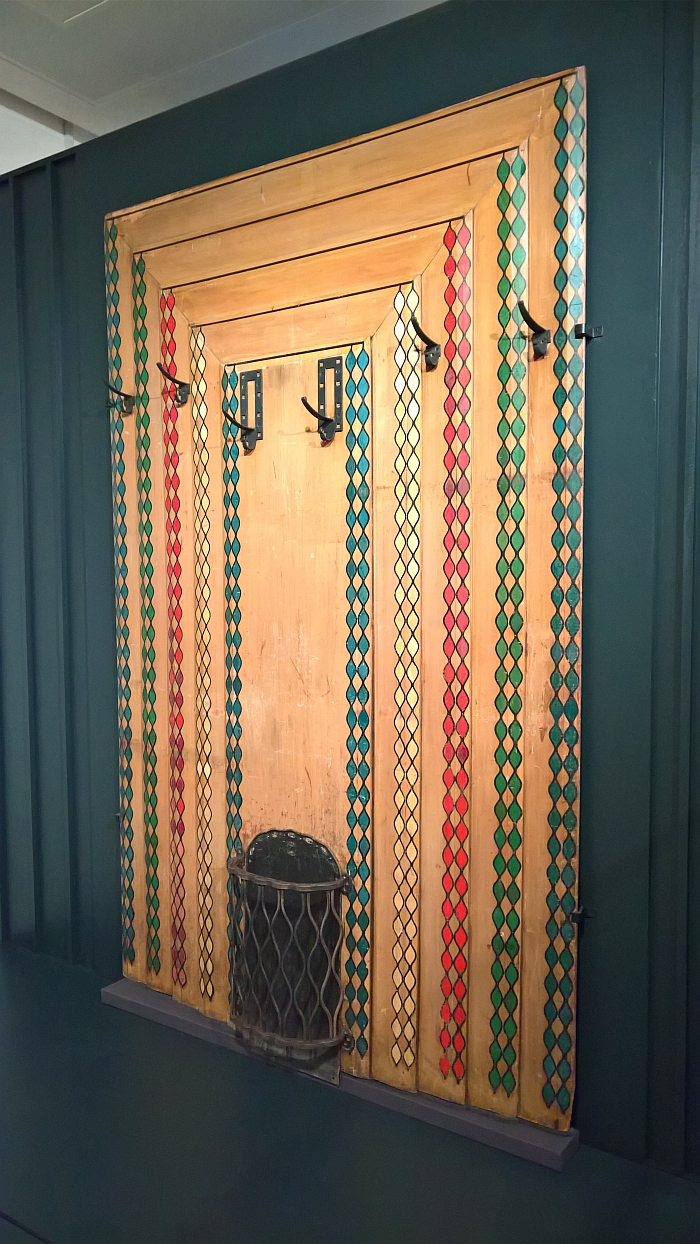
Wall panel for the cloister room, Ingram Street tearooms, as seen at Charles Rennie Mackintosh. Making the Glasgow Style, Kelvingrove Art Gallery and Museum, Glasgow
Presenting some 250 objects from Charles Rennie Mackintosh and contemporaries, and from across creative genres, Making the Glasgow Style is about more than its title star; rather Mackintosh’s (late/rediscovered) fame provides for an accessible narrative on art, architecture and design in and around Glasgow at the turn of the 19th/20th century, provides as it were a rock on which to anchor the story of the local, regional responses to the international developments of the era and how Art Nouveau in Glasgow developed in tandem with that elsewhere, in discourse with international developments, but always in context of its local conditions and with a regional dialect. Ye ken, like.
By nature of the types of objects shown and their inevitable age, Making the Glasgow Style is by necessity a lot of objects in display cases, which as we all know is never an ideal presentation concept, never a satisfying concept and one which when combined with the relative compactness of the Kelvingrove Museum’s temporary exhibition space could easily result in a very banal, uninspiring, over demanding presentation.
Could.
However the presentation concept makes intelligent use of the floor plan to create a series of digestible, self-contained chapters which move the story on in a logical fashion, while the flow of vitrines is neatly interrupted by larger objects, for all furniture, but also a manifold of sketches, photographs, paintings and salvaged interior decoration. Particularly interesting in context of the later are the stencils used for the tearoom wall decorations: a stencil might not sound progressive, but in context of the considerations on standardisation and industrialisation of the day, is a relatively radical step from laboriously hand painted details.
And thus the stencils stand in many regards proxy for how Charles Rennie Mackintosh sought to rationalise, not just formally, but in terms of construction, material and process; how he sought to move ornamentation on from something that existed in its own right and thereby something which was deemed to add value to an object, to something that was a logical and inherent component of an object; to remove the superfluous from existing architectural genres and create contemporary interpretations of, more or less, vernacular Scottish architecture; and generally sought to make architecture and design relevant for the coming age.
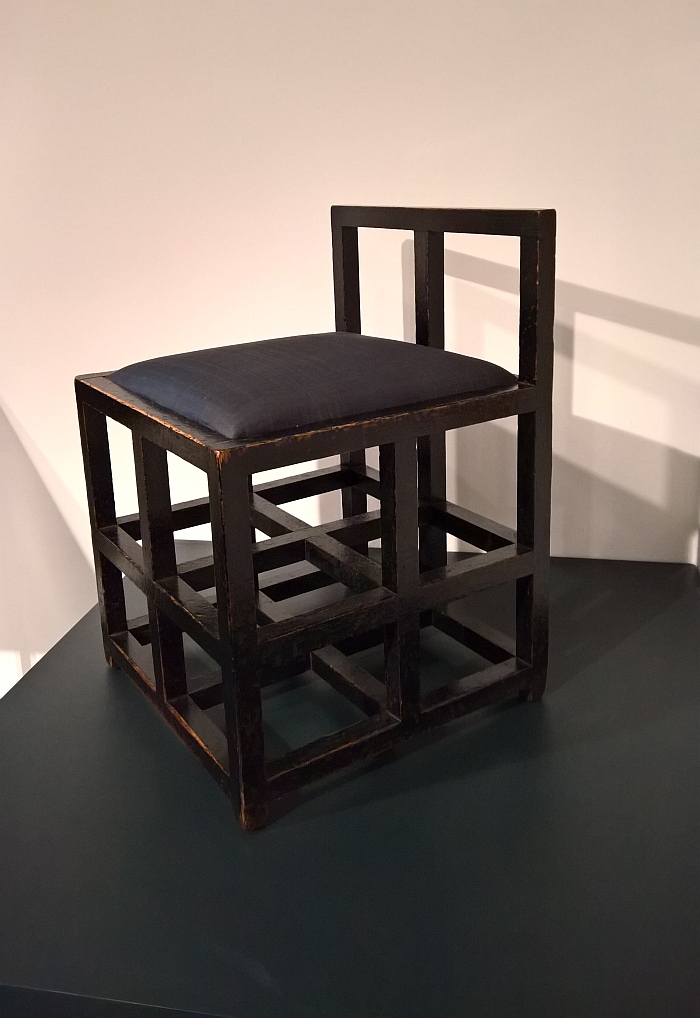
Stool for the Willow Tearooms by Charles Rennie Mackintosh, as seen at Charles Rennie Mackintosh. Making the Glasgow Style, Kelvingrove Art Gallery and Museum, Glasgow
Wider than it is deep Making the Glasgow Style involves a degree of application on behalf of the visitor, it’s not all presented on a plate, you have to work a little yourself, but, and as ever, we assume you are there to learn; do that and you’ll discover a very accessible and reasoned introduction to not only Charles Rennie Mackintosh’s importance and relevance for the development of architecture and design, but also that of his contemporaries and his native city.
And an introduction which is the perfect place from which to head out and explore further, Glasgow being as it is still home to many of the locations and buildings associated with Charles Rennie Mackintosh and his contemporaries, while the nearby Hunterian Museum with its, recreated, Charles Rennie Mackintosh house, offers a presentation of furniture, furnishings and applied arts developed by The Four in room settings; settings which provide a pleasing alternative impression of works viewed in the Making the Glasgow Style and therefore an interesting and valuable reinforcement of that learned. Sadly the powers that be don’t appear to have succumbed to the irresistible logic of a combi-ticket for both presentations, and so you’ll have to, as it were, go alone. If you decide to crawl, stumble or stagger between the two is entirely up to you.
Charles Rennie Mackintosh. Making the Glasgow Style runs at the Kelvingrove Art Gallery and Museum, Argyle Street, Glasgow, G3 8AG until Tuesday August 14th
Full details, including information on the supporting fringe programme can be found at www.glasgowlife.org.uk
2. Neil Jackson, Found in Translation: Mackintosh, Muthesius, and Japan, Japan Society Proceedings https://livrepository.liverpool.ac.uk/2010331/1/Japan%20Soceity%20proceedings.pdf Accessed 05.04.2018
3. Robert Hurd, Charles Rennie MacKintosh Exhibition, The Spectator, 26th May 1933 http://archive.spectator.co.uk/article/26th-may-1933/17/charles-rennie-mackintosh-exhibition Accessed 05.04.2018
- Wall section from Ingram St tearooms, as seen at Charles Rennie Mackintosh. Making the Glasgow Style, Kelvingrove Art Gallery and Museum, Glasgow
- Mackintosh was apparently keen on symbolism…… A tearoom stencil, as seen at Charles Rennie Mackintosh. Making the Glasgow Style, Kelvingrove Art Gallery and Museum, Glasgow
- Pendant light from Ingram St tearoom, as seen at Charles Rennie Mackintosh. Making the Glasgow Style, Kelvingrove Art Gallery and Museum, Glasgow
- A video of Mackintosh’s masterworks, as seen at Charles Rennie Mackintosh. Making the Glasgow Style, Kelvingrove Art Gallery and Museum, Glasgow
- 1920s paintings by Charles Rennie Mackintosh and Margaret Macdonald, as seen at Charles Rennie Mackintosh. Making the Glasgow Style, Kelvingrove Art Gallery and Museum, Glasgow
- Charles Rennie Mackintosh. Making the Glasgow Style @ Kelvingrove Art Gallery and Museum, Glasgow
Tagged with: Charles Rennie Mackintosh, Glasgow, Making the Glasgow Style, Margaret Macdonald
